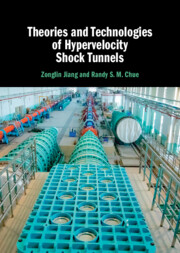Book contents
- Theories and Technologies of Hypervelocity Shock Tunnels
- Theories and Technologies of Hypervelocity Shock Tunnels
- Copyright page
- Contents
- Preface
- 1 Introduction
- 2 Shock-Wave Relations and Aerothermodynamic States
- 3 Heated Light-Gas High-Enthalpy Shock Tunnels
- 4 Free-Piston-Driven High-Enthalpy Shock Tunnels
- 5 Detonation-Driven High-Enthalpy Shock Tunnels
- 6 Theory and Methods for Long-Test-Duration Shock Tunnels
- 7 Methods for Designing High-Enthalpy Flow Nozzles
- 8 Aerothermodynamic Testing and Hypersonic Physics
- Index
- References
5 - Detonation-Driven High-Enthalpy Shock Tunnels
- Theories and Technologies of Hypervelocity Shock Tunnels
- Theories and Technologies of Hypervelocity Shock Tunnels
- Copyright page
- Contents
- Preface
- 1 Introduction
- 2 Shock-Wave Relations and Aerothermodynamic States
- 3 Heated Light-Gas High-Enthalpy Shock Tunnels
- 4 Free-Piston-Driven High-Enthalpy Shock Tunnels
- 5 Detonation-Driven High-Enthalpy Shock Tunnels
- 6 Theory and Methods for Long-Test-Duration Shock Tunnels
- 7 Methods for Designing High-Enthalpy Flow Nozzles
- 8 Aerothermodynamic Testing and Hypersonic Physics
- Index
- References
Summary
The detonation-driven shock tunnel is one of three important classes of hypersonic and high-enthalpy ground testing facilities that are based on the shock-heated principle. The theory and methods for developing the detonation-driven shock tunnels aiming at hypervelocity flow generation are summarized in this chapter. At first, the primary concepts for detonation drivers are presented to demonstrate their unique advantages for aerodynamic ground-based testing. The difficult problems arising from the development of hypervelocity shock tunnels for simulating flight conditions are identified and discussed in detail to address critical issues underlying the high-enthalpy shock tunnel design. Then, three kinds of detonation-driven shock tunnels are introduced, and their key techniques and performances are reviewed and discussed in detail. Finally, some experiments are summarized to demonstrate the capability of the detonation-driven hypersonic shock tunnel and the importance of the measurement techniques for hypersonic and high-temperature flow experiments. Both are the frontiers of high-enthalpy flow research for developing hypersonic vehicles.
- Type
- Chapter
- Information
- Theories and Technologies of Hypervelocity Shock Tunnels , pp. 119 - 164Publisher: Cambridge University PressPrint publication year: 2023



